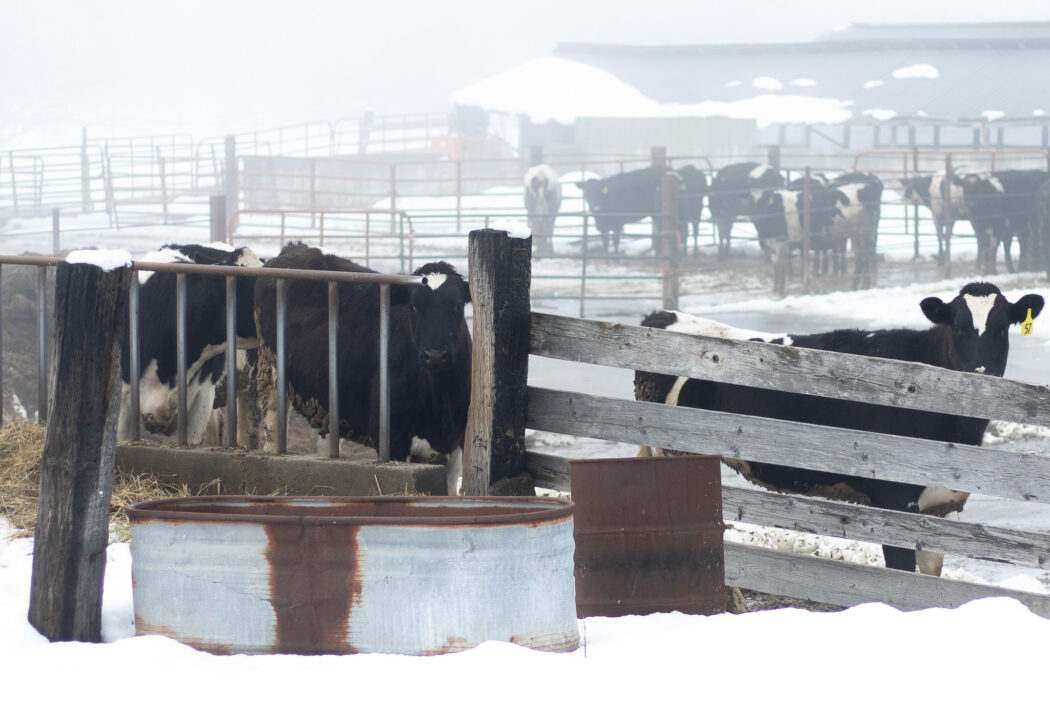Cache Valley agriculture causes air pollution, experts speak on solutions
On some days, someone looking over Cache Valley from above would see a gray cloud of smog covering the area.
More than just morning or evening fog, these polluted air masses significantly reduce air quality. But Logan is not a bustling metropolis, so where is the pollution problem is coming from?
Randy Martin, an environmental professor at USU and an expert in air quality, has been researching levels of air pollution in the valley for years.
Inversion, the trapping of cooler air below warmer air, is a phenomenon that contributes heavily to air pollution, and one that Cache Valley falls victim to.
“It is a meteorological phenomenon that has absolutely nothing to do with air pollution by itself,” Martin said.
Martin said when warm air gets trapped, it prevents vertical mixing, which in turn traps the pollution near the Earth’s surface.
According to Martin, the amount of pollution that Cache Valley inversion captures and holds is due to the bathtub-like shape of the valley itself. The valley has no open areas for the pollution to leak out of.
“The inversion is basically putting a cap on our bathtub that Cache Valley is,” Martin said. “All of those pollution sources that are then in the valley contribute to our air pollution problem.”
According to Martin, the main pollutant trapped is PM2.5, or fine particulate matter.
“PM2.5 by definition is a continuum of particle sizes less than or equal to 2.5 in diameter, and the reason that’s important is because that’s kind of the magic number that you can breathe into your respiratory system,” Martin said. “It is a very effective size at causing health problems.”
According to Martin, there is a specific kind of PM2.5 that Cache Valley tends to produce and trap the most of: ammonium nitrate.
“We are what we call ammonia-rich,” Martin said. “We have more ammonia in our atmosphere than anywhere else in the country.”
This excess ammonia is not natural. According to Martin, Cache Valley’s fervent agricultural industry is one of the largest producers of ammonia.
“It’s not that we have more ammonia being emitted, but because we live in this valley, we trap it here,” Martin said.
Kelsey Hall, a USU Extension specialist and associate professor of agricultural communications, has extensive educational and professional background within the field of agriculture.
“For Cache County, I would focus on the ammonia-based air pollution that often comes from the agriculture industry and from transportation,” Hall said.
According to Hall, ammonia is also produced naturally by the biological waste of animals.
“If you have ammonia in the atmosphere, and nitric acid in the atmosphere, they will grab onto each other and form ammonium nitrate,” Martin said. “If you’re going to try to control your PM2.5, you have to look at the nitric acid side, so where does the nitric acid come from?”
According to Martin, nitric acid is a combination of oxides of nitrogen and hydrocarbons, or volatile organic compounds. These chemicals are produced by combustion and transportation.
“That’s why we have inspection maintenance programs on your automobiles,” Martin said. “That’s why we have regulations on what kind of solvents auto body paint shops can use.”
Cache Valley has been working towards reducing ammonia, nitric acid and other pollutants by using forms of regulation and education, both on an industry level and an individual level.
There are efforts to control emissions from agricultural industries specifically.
“There’s things we can do on the management side of things, and there are things we can do on the feed side of things,” Martin said.
According to Martin, one thing agricultural producers can do to reduce their ammonia production is to reduce the amount of protein in their livestock’s diet and manage their manure.
According to Hall, USU Extension is working with and educating farmers in the area about good agricultural practices that reduce emissions. These practices include cover cropping, feed management for livestock and management and application of organic fertilizers.
“Thinking about nutrient conservation — reducing fertilizer use — we have better technology that’s helping to know how much to apply and where to apply it to our soil,” Hall said.
According to Hall, furthering education and understanding these alternative agricultural practices can reduce emissions.
Successful sustainable agriculture is happening elsewhere too, through the application of good agricultural practices.
Temis Taylor is an AmeriCorps program coordinator with the Utah Conservation Corps, an organization that focuses on environmental education projects.
The UCC works with some organic farms within Cache Valley, such as the USU Student Organic Farm and the Urban Community farm. They aim to run their farms using sustainable practices.
According to Taylor, cover cropping and integration of animals into farms to help reduce pests limits the need for fertilizer, another contributor to air pollution.
“We’re intercropping, and we’re rotating things so that we don’t have to spray,” Taylor said.
There are other initiatives in the valley that urge individuals to be aware of their own pollution emissions, especially relating to transportation.
“We have seen initiatives for improving bicycles in our valley and trying to have bicycle lanes, and also educating people about using bicycles for transportation,” Hall said.
Public transportation is an alternative to driving that can also aid in reducing emissions.
“I know that we’ve made progress on our bus system, and that they’ve done a lot to improve the motors in the buses and try to bring down that air pollution,” Hall said.
According to Martin, the efforts have not been in vain.
“We know what we have to do, and we’ve done a pretty good job,” Martin said. “Here in Cache Valley, we don’t see nearly as high levels of emissions as we did in the early 2000s.”
Martin said the work towards improving Cache Valley’s air quality is a community effort.
“Everybody’s got be a part of the solution,” Martin said.

